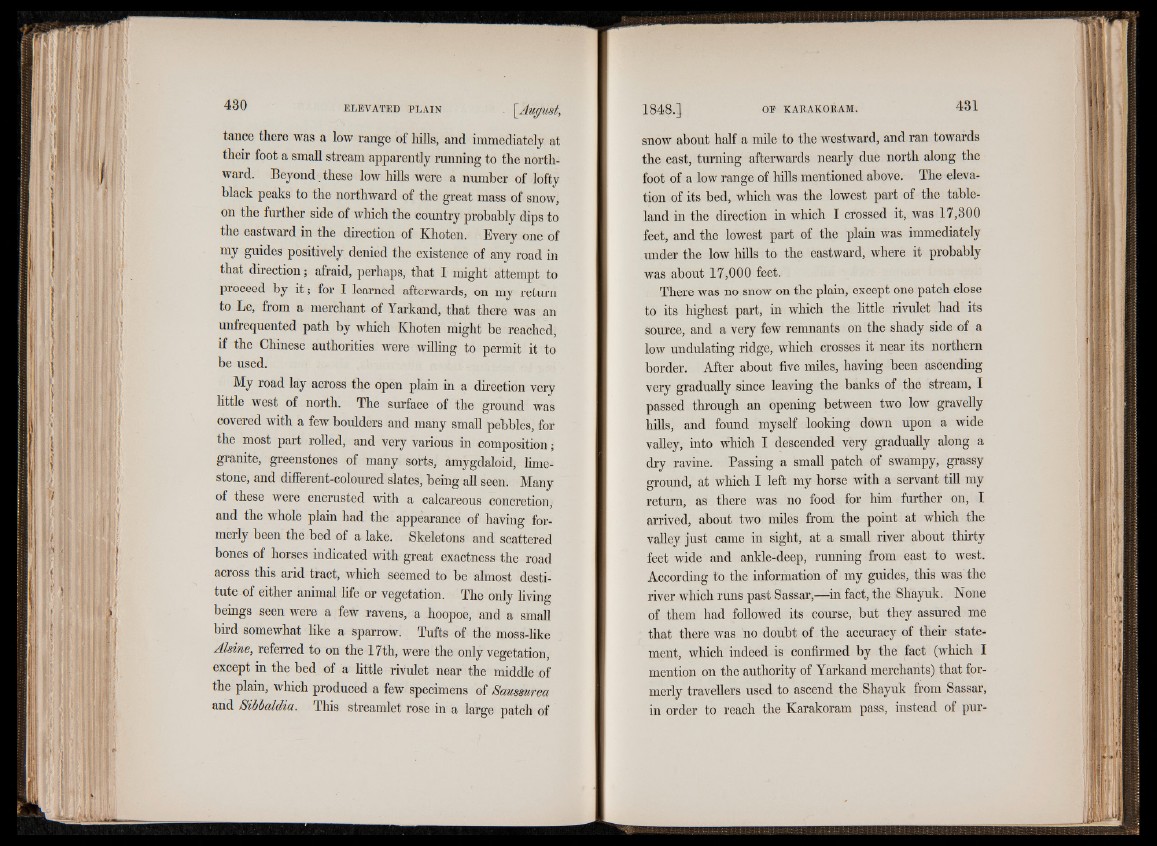
tance there was a low range of hills, and immediately at
their foot a small stream apparently running to the northward.
Beyond these low hills were a number of lofty
black peaks to the northward of the great mass of snow,
on the further side of which the country probably dips to
the eastward in the direction of Khoten. Every one of
my guides positively denied the existence of any road in
that direction; afraid, perhaps, that I might attempt to
proceed by it; for I learned afterwards, on my return
to Le, from a merchant of Yarkand, that there was an
unfrequented path by which Khoten might be reached,
if the Chinese authorities were willing to permit it to
be used.
My road lay acfoss the open plain in a direction very
little west of north. The surface of the ground was
covered with a few boulders and many small pebbles, for
the most part rolled, and very various in composition;
granite, greenstones of many sorts, amygdaloid, limestone,
and different-coloured slates, being all seen. Many
of these were encrusted with a calcareous concretion,
and the whole plain had the appearance of having formerly
been the bed of a lake. Skeletons and scattered
bones of horses indicated with great exactness the road
across this arid tract, which seemed to be almost destitute
of either animal life or vegetation. The only living
beings seen were a few ravens, a hoopoe, and a small
bird somewhat like a sparrow. Tufts of the moss-like
Alsine, referred to on the 17th, were the only vegetation,
except in the bed of a little rivulet near the middle of
the plain, which produced a few specimens of Sausmrea
and Sibbaldia. This streamlet rose in a large patch of
snow about half a mile to the westward, and ran towards
the east, turning afterwards nearly due north along the
foot of a low range of hills mentioned above. The elevation
of its bed, which was the lowest part of the tableland
in the direction in which I crossed it, was 17,300
feet, and the lowest part of the plain was immediately
under the low hills to the eastward, where it probably
was about 17,000 feet.
There was no snow on the plain, except one patch close
to its highest part, in which the little rivulet had its
source, and a very few remnants on the shady side of a
low undulating ridge, which crosses it near its northern
border. After about five miles, having been ascending
very gradually since leaving the banks of the stream, I
passed through an opening between two low gravelly
hills, and found myself looking down upon a wide
valley, into which I descended very gradually along a
dry ravine. Passing a small patch of swampy, grassy
ground, at which I left my horse with a servant till my
return, as there was no food for him further on, I
arrived, about two miles from the point at which the
valley just came in sight, at a small river about thirty
feet wide and ankle-deep, running from east to west.
According to the information of my guides, this was the
river which runs past Sassar,—in fact, the Shayuk. None
of them had followed its course, but they assured me
that there was no doubt of the accuracy of their statement,
which indeed is confirmed by the fact (which I
mention on the authority of Yarkand merchants) that formerly
travellers used to ascend the Shayuk from Sassar,
in order to reach the Karakoram pass, instead of pur